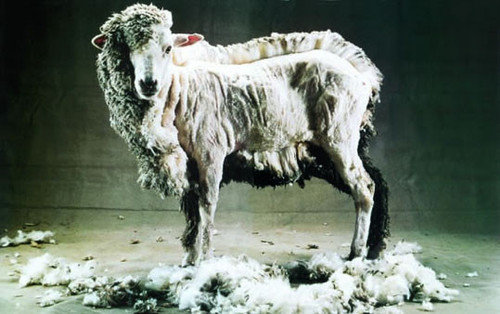Radical Advertising
dal 4/4/2008 al 25/8/2008
Segnalato da
4/4/2008
Radical Advertising
NRW - Forum Kultur und Wirtschaft, Dusseldorf
The exhibition will recreate spectacular ambient advertising campaigns in 3-D and introduce the visitor to the advertising world of Web2.0 and Youtube. The heart of the display is a Comme des Garcons guerrilla store containing both retro products and the label's most recent designs.

Radical Advertising, an NRW-Forum Kultur und Wirtschaft exhibition, will be open to the public from 5 April to 26 August 2008. Both the exhibition and its provocative title show that the transition from the 20th to the 21st century marked a radical paradigm shift in advertising.
Against the backdrop of globalization, the 1990s became the decade of the no-logo movement and ‘ad-busting’, an attack on the cluttering of the semiotic environment with advertising messages.
The fashion industry was instrumental in this regard: not only did it make it fashionable to wear hijacked logos, it also successfully employed anti-advertising techniques in its marketing campaigns. In doing so, it spearheaded a radically changed concept of advertising that successfully incorporated political and artistic attacks on global advertising into its campaigns. The RADICAL ADVERTISING exhibition features ad-buster campaigns, the critical artistic reflections of artists such as Jeff Koons, Damien Hirst, Cindy Sherman, and Daniel Buetti, and the opinion-forming campaigns of Benetton, Sisley, Diesel, Helmut Lang, Calvin Klein, and Comme des Garçons.
Many of the advertisements that appeared on billboards or in magazines in the 1980s and 1990s were designed to shock. They not only revolutionised the advertising industry, but also generated heated debates among members of the public. The controversy generated by Benetton, for example, was so intense that some magazines refused to print Benetton advertisements featuring images of death row in American prisons and some retailers stopped stocking Benetton products.
The nineties: radical shock - advertising as a means of attack
The noughties: radical life - advertising as a means of making contact
2010 onwards: radical moral - advertising as a means of co-operation
... these are the central themes of the exhibition.
Since the 1990s, globalization has also produced a fundamental change in the way consumers consume the media. In the 21st century, advertising has reacted to the media overkill caused by the complete fragmentation of television and the advent of the Internet, mobile telephony, and instant messaging with a second, equally radical u-turn: it is withdrawing from mass communication and addressing individuals wherever it encounters them. The relationship with the consumer has changed from being a passive one to being an active one. Buzz marketing, guerrilla advertising, ambient advertising, and Web2.0 have created the participating consumer.
The Radical Advertising exhibition will recreate spectacular ambient advertising campaigns in 3-D and introduce the visitor to the advertising world of Web2.0 and Youtube. Exhibits include a MINI that was converted into a hotel room (and parked outside Germany’s World Cup stadiums); a manhole cover that startles the visitor because of the two hands that reach out from beneath it (for Amnesty International); an interactive urinal advertising Frankfurt’s taxi guild; and a dedicated blog written by the popular German comic figure, Horst Schlämmer, advertising Volkswagen products.
Here too, artists launch a subversive and aggressive attack on the world of advertising: Zevs ‘kidnaps’ advertising figures from posters and Tom Sachs ‘crafts’ a model of a McDonald’s fast food restaurant...
... the final campaign highlighted in this series is the one run by American Apparel, a company that chooses not to brand its products with a logo and uses its customers as models in its advertisements. In the spirit of Andy Warhol, everyone in this campaign gets their 15 minutes of fame and it is the consumers who shape the advertisements that seek to encourage them to buy products.
The heart of the exhibition is a Comme des Garçons guerrilla store containing both retro products and the label’s most recent designs. The store will appear at the launch of the exhibition and disappear again when it ends. Although Comme des Garçons has already applied the guerilla store concept in a variety of cities (including Berlin, Singapore, Krakow, and Glasgow), this is the very first time it has used it in a museum. The store rebelliously carries to extremes the notion of the increasingly mercantile nature of museums. It will be surrounded by a wire fence: on one side of the fence, visitors to the store will look out through the wire mesh into the museum, while on the other side, visitors to the museum will catch glimpses of the glittering world of consumerism through the wire barrier.
The term ‘radical’ covers both meanings of the word: ‘radical’ in the sense of revolutionary and ‘radical’ in the opposing sense of fundamental or absolute. This is exactly what the RADICAL ADVERTISING exhibition is about: advertising’s fundamentally different approach, an approach that is revolutionary because it turns the fundamental principles of the system upside down.
The Radical Advertising exhibition uses numerous examples to illustrate the history of shock advertising and employs the shortest-lived examples of the genre to bring visitors not only close to, but actually into pop-up stores and guerilla marketing campaigns.
The 400-page exhibition catalogue (on sale for only € 29.90!) contains essays by Werner Lippert, Peter Wippermann, and Diederich Diederichsen, hundreds of photos, and countless interviews by Hermann Vaske with radical advertising protagonists such as Renzo Rosso (Diesel), Oliviero Toscani (Benetton), Kalle Lasn (the founder of Adbusters), and other creative minds from around the world.
The pop band MIA and its singer Mieze provide a completely different perspective on the exhibition. Visitors can listen to MIA’s exhibition guide using any Bluetooth-equipped mobile phone or watch it as a podcast on the NRW-Forum website (www.nrw-forum.de).
This exhibition is sponsored by Diesel, OMD, Wall, and Nokia.
Press relations:
Petra Wenzel, Werner Lippert
Tel.: +49 (0)211 9660036 info@projects.ag
NRW-Forum Kultur und Wirtschaft
Ehrenhof 2 - 40479 Düsseldorf
Tue-Sun: 11 a.m.-8 p.m.; Fri: until midnight



